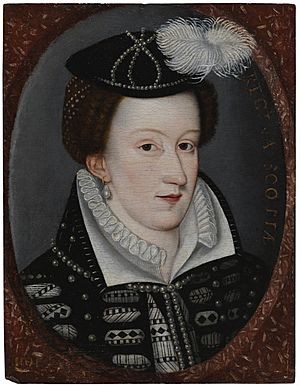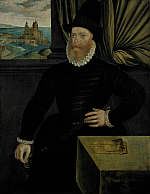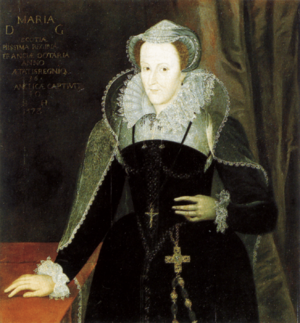Jewels of Mary, Queen of Scots facts for kids
Mary, Queen of Scots (born in 1542, died in 1587), owned many beautiful jewels. We know about them mostly from old lists kept by the National Records of Scotland. She received jewels as gifts when she was a child in France. She also inherited some from her father. Mary loved to give jewels as presents to her friends and to important visitors.
When Mary left Scotland for England, many of her jewels were sold or used as security for loans. This happened first by her enemies and later by her friends. Even in England, Mary kept buying new jewels, some from France. She used them to reward people who supported her. In Scotland, her son, James VI, and his friends wore the jewels she left behind.
Contents
- French Fashion and the Scottish Queen
- Gems and Their Shapes
- Mary Returns to Scotland
- Rings for Elizabeth and Mary
- John Knox's Opinion on Court Fashions
- Gifts and Jewels at the Scottish Court
- Marriage, Pregnancy, and the Queen's Will
- The Lion and the Mouse
- Regent Moray and the Queen's Jewels
- Mary Escapes and Goes to England
- Jewels and the Lang Siege
- Regent Morton and the Jewels
- Mary in England
- Jewels and Portraits with Political Messages
- Relics and the Earl of Northumberland
- Crucifixes and Rosaries
- James VI
- The Eglinton Parure
- The Penicuik Jewels and Gillis Mowbray
- The Inventories
French Fashion and the Scottish Queen
Mary inherited jewels from her father, James V of Scotland. For a time, the Regent Arran ruled Scotland. In 1556, after Mary's mother, Mary of Guise, became regent, a large collection of royal jewels was sent to Mary in France. One special jewel was a pendant or hat badge made in Edinburgh. It was crafted from Scottish gold and featured a mermaid with diamonds, holding a mirror and a ruby comb.
Mary had her jewels fixed and updated by jewelers in Paris. These jewelers also provided other items like gloves, pins, and brushes. Her clothes were often decorated with jewels. For example, a white satin skirt had 120 diamonds and rubies. Her hairnets had gold buttons or rubies sewn onto them.
In 1554, Mary's governess wanted to buy two diamonds. These were to make one of Mary's headbands longer. This headband already had rubies and pearls set in gold. The governess also wanted to buy a fancy gold dress for Mary. This dress was for a wedding and was meant to look like the fashionable clothes worn by French princesses.
An artist named Jean Court, who worked with enamel on metal, decorated a special cup for Mary. This cup had scenes of gods and goddesses, and it showed the coat of arms of Scotland. It is thought that this cup might have been made for Mary's engagement.
Jewels for a Royal Wedding
Mary's mother asked her to buy a special chiming watch from a famous maker. Mary was engaged to the French prince, Francis II of France. For their wedding in 1558, she wore many jewels that belonged to the French crown. Her necklace had a pendant of "priceless value." Mary wrote that the French King, Henry II, and her uncles gave her a border for her French hood, covered in precious stones.
On her wedding day, a famous ruby called the "Egg of Naples" hung from her crown on her forehead. Mary's mother-in-law, Catherine de' Medici, gave her a necklace and pendant. Many goldsmiths worked on Mary's wedding jewels. Two merchants supplied a special diamond for Catherine de' Medici's necklace gift. This diamond cost 380 French livres. The pendant might have been the jewel later known as the Great H of Scotland.
In 1559, Mary ordered fake jewels for costumes for a play. These were for the weddings of other princesses. Soon after, King Henry II died. Mary asked the Duchess of Valentinois to make a list of all the French king's jewels.
Years later, in the 1570s, Mary sent a jewel to her godchild. This jewel had been a gift to Mary from King Henry II when she was a child. It showed her affection for the girl and her family.
Gems and Their Shapes
Mary's records show she bought jewelry and precious stones from French jewelers even when she was in Scotland. She bought items worth £2000 Scots in May 1566. The lists of Mary's jewels describe the shapes of the stones. They mention facets, points, triangles, and square cuts. A diamond that was "square" was table-cut. A "cabochon" was a rounded stone. Mary had a sapphire cut like eight petals. A small sapphire set "a jour" (meaning it was finely cut and clear) was believed to help sore eyes. This sapphire was pierced to be worn as a pendant.
Heart-shaped stones were very popular. Mary and Elizabeth I exchanged them as gifts in the 1560s. Mary sent Elizabeth a "fair ring with a diamond made like a heart." In 1581, Mary sent a ring to her son, James VI, which he received "in good heart." This ring may have had a heart-shaped diamond.
Diamonds during this time came from India. Many were cut and traded in Antwerp. Natural diamond crystals that did not need cutting were sold in Paris and Lisbon. Sometimes, rock crystal or glass was used instead of real diamonds. Rubies came from Myanmar, and sapphires from Sri Lanka and Myanmar. Emeralds came from the Salzburg Alps and Colombia. Turquoise came from Iran and the Sinai. A costly "oriental amethyst" was likely a purple ruby or sapphire, not a quartz amethyst.
The old lists do not say much about the gold settings, except for the colors of any enamel. Gold used in jewelry from this time was usually about 21 carats pure.
Pearls
In 1562, Mary bought 264 large pearls from an Edinburgh goldsmith. Some were sent to Paris to be made into buttons. Others were used in jewelry made in Edinburgh. Most pearls came from marine oysters and were imported. In the 1500s, pearls were gathered by divers in Venezuela and the Indian Ocean.
Scottish freshwater pearls were also used. They were usually smaller than marine pearls. Scottish pearls were exported to Flanders as early as 1435. In 1568, some of Mary's pearls were sold to Elizabeth I. These included pearls as big as nutmegs.
Mary Returns to Scotland
After Francis II died in December 1560, Mary had to return many French crown jewels. These included diamonds, a large ruby called the "Egg of Naples," and a large emerald from Peru. Mary was allowed to keep some pieces. She later said that much of her personal jewelry had been given to her in France.
When Mary arrived in Scotland in September 1561, her luggage included many costly jewels and gold items. She also had precious stones and "orient pearls," which were considered the best in Europe. Jewels for daily use were kept near her bedroom. One of her French ladies was given linen to store these jewels.
Mary had several sets of matching headpieces and necklaces. These were worn on the headband of a French hood. One set of large pearls was sewn onto black velvet. Mary also had clothes heavily decorated with pearls, including a black velvet trim for a gown. Her earrings were called "hingaris at luggis" in Scots.
Watches linked to Mary were made in France. One watch was said to have been lost near Jedburgh and found much later. The symbols on one of her watches were recorded in 1575. Some of these symbols were also embroidered by Mary and Bess of Hardwick on the Oxburgh Hangings.
Rings for Elizabeth and Mary
Kings and queens often exchanged jewels as gifts. These gifts could have different meanings. Queen Elizabeth I of England wanted to send her portrait to Mary in 1562, but her painter was sick.
Mary told the English ambassador that she would send Elizabeth a heart-shaped diamond ring. She hoped to meet Elizabeth and become "good sisters." Mary put Elizabeth's letter near her heart.
In 1563, at a special holiday called Epiphany, Mary Beaton played Queen of the Bean. The ambassador described Mary wearing only the ring he brought from Queen Elizabeth, hanging at her chest on a white and black lace.
James Melville of Halhill met Elizabeth I in 1564. He asked if she would send Mary a picture of the Earl of Leicester or a "fair ruby, great like a racket ball." Elizabeth said Mary would get both if she followed her advice. Melville returned to Scotland with a diamond ring for Mary from Margaret Douglas.
A Diamond Speaks
A writer named George Buchanan wrote poems about Mary's diamond ring gifts to Elizabeth. One poem was called "A Diamond Talks." The gift was widely known. An English bishop was unsure about Mary's plans for a meeting with Elizabeth. The heart-shaped diamond and poems were linked to plans for a meeting between the two queens. This meeting was planned for Nottingham, then York, but it never happened.
Mary mentioned a ring Elizabeth sent her for "her help" in a letter from Lochleven Castle in 1568. The exchange of rings and a promise of help became a common theme. Mary mentioned the heart-shaped diamond again in a letter from Carlisle Castle. She wrote, "Remember that I kept my promise when I sent you my heart in a ring."
In 1586, James VI heard that Mary showed the ring Elizabeth sent her as a sign of faith during her trial. Mary said she had trusted this promise and was now paying the price.
Two Jewels I Have
Elizabeth sent Mary a diamond ring in December 1563, which Mary "marvelously esteemed." Elizabeth was trying to influence Mary's marriage plans. Mary was in bed after dancing at her 21st birthday party. She showed Elizabeth's diamond ring on her finger. Then Mary showed the ring from her marriage to Francis II, saying, "two jewels I have that must die with me, and willingly shall never out of my sight."
Later, Mary toasted Elizabeth as "De Bon Coeur," meaning "of good heart." This phrase was sometimes used on rings. In 1564, Mary wore no other jewels except the diamond ring from Elizabeth, worn as a pendant.
Mary's Portrait and Elizabeth I
Elizabeth I received a small portrait of Mary. In 1564, she showed it to the Scottish envoy, Sir James Melville. Elizabeth gave Melville a diamond as a token for Mary. In 1566, Elizabeth I wore a small portrait of Mary on a gold chain. She showed it to the Spanish ambassador, saying she was sorry about Mary's troubles and the murder of David Rizzio.
John Knox's Opinion on Court Fashions
John Knox did not like the jewelry worn by Mary's ladies-in-waiting. He described a meeting with Mary in 1563. Afterward, he told the ladies that they could not take their "gay gear" to heaven. He meant their gold, jewels, pearls, and precious stones. "Garnishings" were headpieces for French hoods, and "targets" were brooches.
Knox also criticized the women's fancy clothes at Parliament. He said preachers spoke against the "stinking pride of women" and their "taregetting of their taillies" (decorating their costumes). There were calls for laws to control clothing styles.
Gifts and Jewels at the Scottish Court
In October 1564, Matthew Stewart, 4th Earl of Lennox, arrived at the Scottish court. He gave Mary a "marvelous fair and rich" jewel, a clock, and a mirror set with precious stones. He also gave diamond rings to courtiers and presents to Mary's four ladies-in-waiting. The English ambassador saw Mary playing dice with Lennox, wearing a mask, and losing a "pretty jewel of crystal" to him.
In July 1565, Mary paid a French goldsmith, probably for gifts for her wedding to Henry Stuart, Lord Darnley. Mary also employed goldsmiths in Edinburgh. In 1562, she bought 64 large pearls from an Edinburgh goldsmith. Some were added to a gold "pair of hours," some sent to Paris for buttons, and the rest used in a chain with rubies and diamonds.
A gold locket with a cameo portrait of Mary, shaped like a heart with a ruby tail, is now at the National Museum of Scotland. It was once thought to be from Mary's time, but it is now known to be from the 1800s. However, the cameo portrait itself seems to be from Mary's era. Mary wrote to France for portrait jewels in 1575, possibly cameos or miniature paintings, to give to her supporters.
Marriage, Pregnancy, and the Queen's Will
Mary married Lord Darnley with three rings, including a rich diamond. Soon after, they faced a rebellion. Needing money, they tried to pawn some of her jewels in Edinburgh for 2,000 English marks, but no one would lend that much.
When Mary was pregnant in 1566, she made a list of her jewels. She left some as gifts to the Scottish crown and others to her family and ladies-in-waiting. This list was like a will. It was found in Edinburgh in 1854. Mary Livingston and Margaret Carwood helped her and signed the documents. The jewels were sorted into categories.
Mary wanted the Earl of Bothwell to have a hat jewel with a mermaid, diamonds, and a ruby. A hat badge shaped like a turtle with ten rubies was a gift from David Rizzio. Mary left it to his brother. Her four-year-old nephew would have received gold buttons and a piece of unicorn horn on a silver chain, believed to test for poison.
Marten Furs and Zibellini

If Mary had died during childbirth, her lady-in-waiting, Annabell Murray, Countess of Mar, would have received jewels. These included a belt of amethysts and pearls, bracelets with diamonds, rubies, and pearls, and pearl earrings. She would also have received a "zibellino," which was a marten fur with a gold head and jeweled feet.
Mary's mother had a gold marten's head made in 1539. Mary had several of these, some with rock crystal heads. She gave her mother's fur with a gold head and feet to a lady to mend. In 1568, Mary left her furs and jeweled heads in Scotland.
In 1580, Mary asked for a "double marten" with a gold head and feet, set with precious stones. She wanted to give it as a gift at a christening. If she couldn't get one, she suggested a jeweled night cap and collar instead. These fur accessories were sometimes linked to pregnancy.
Scented Pomander Beads and the Rosary
Mary had two sets of head-dresses, necklaces, and belts with openwork gold beads. These beads could be filled with scented musk. Mary gave one set to her half-sister and the other to her sister-in-law. These items are not in later Scottish lists, so Mary may have given them away. The beads are called "pomander" beads because of the sweet scent inside.
Mary also had scented bracelets. In 1568, she sent a chain of pomander beads to Catherine, Lady Knollys, the wife of her keeper at Bolton Castle.
Rosary beads were called "pairs of beads." Larger beads separating groups of ten were called "gawds." Mary gave a "pair of beads of gold of perfume" to Anne Percy, which had been a gift from the Pope. The Penicuik necklace, now in the National Museums of Scotland, has these types of pomander beads. It was a gift from Mary to Gillis Mowbray.
Mary's execution accounts mention her wearing a chain of pomander beads or a pomander necklace with an "Agnus Dei" (a religious symbol). She also wore a "chaplet or beads, fastened to her girdle, with a gold cross." Her ladies removed her "chayne of pomander beades and all other her apparell."
Mary had written about receiving "chaplets" and an "Agnus Dei" from Rome in 1577. These may be the items mentioned at her execution. The gold rosary beads and crucifix Mary wore are said to be at Arundel Castle.
Gifts at Prince James's Baptism
Mary gave birth to Prince James at Edinburgh Castle. A diamond cross was placed on James's baby clothes. His christening was at Stirling Castle in December 1566. Mary gave her jewels as diplomatic gifts. She gave the Earl of Bedford, who represented Elizabeth I, a gold chain with pearls, diamonds, and rubies. She also gave chains and rings to other English gentlemen. The French ambassador gave her a necklace of pearls and rubies and earrings.
A Ring in the Casket Letters
It was said that Mary gave James Hepburn, 4th Earl of Bothwell jewels worth 20,000 or 30,000 crowns. One of the Casket Letters, which her enemies claimed Mary wrote to Bothwell, describes a ring. This ring was a symbol of her love and loyalty. The letter describes it as a "sepulchre of hard stone, colored with black, sown with tears and bones." The stone was compared to her heart, with Bothwell's name and memory enclosed. The black enamel symbolized her faithfulness.
Some writers believe the diamond in the letter was a jewel Mary had left to Bothwell in her will. Mary owned at least two other black-enameled diamond rings.
The Lion and the Mouse
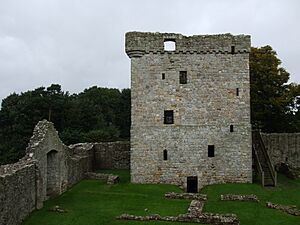
In 1567, Mary was imprisoned in Lochleven Castle. Her allies sent her a gold jewel or ring showing Aesop's fable of the lion and mouse. This was a secret message about escaping. It meant that even a small mouse could help a large lion escape a net. The jewel had an Italian motto: "To those with enough spirit, there is no shortage of strength." Mary wore it, and everyone saw it.
This jewel is likely listed in Mary's final inventory as "A device of Aesop in gold." Another list mentions a round jewel with diamonds and an amethyst engraved with a lion and a motto.
Regent Moray and the Queen's Jewels
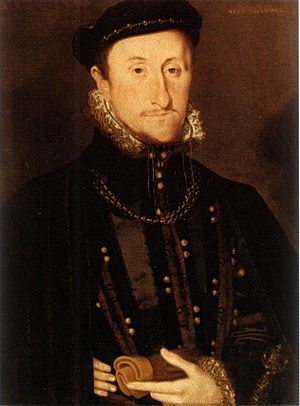
When Mary was imprisoned, the Scottish lords ordered some of her silver to be melted down and made into coins.
Mary had asked an Edinburgh goldsmith to turn a diamond chain into a hairband. The goldsmith gave it to Andrew Melville, who took it to Mary at Lochleven.
Mary's half-brother, James Stewart, 1st Earl of Moray, returned from France. Mary asked him to look after her jewels for her son. Soon after, Moray became the ruler of Scotland, known as Regent Moray. His secretary and Mary's servant made lists of Mary's clothes and jewels.
Mary's jewels and clothes in Edinburgh Castle were given up in September 1567. They were worth much more than expected. Regent Moray appointed his friend as keeper of Edinburgh Castle and the jewel box.
Regent Moray needed money. He used Mary's jewels as security for loans and sold some pieces to Edinburgh merchants. A jewel used as security for a loan was called "laid in wed."
Elizabeth Buys Mary's Pearls
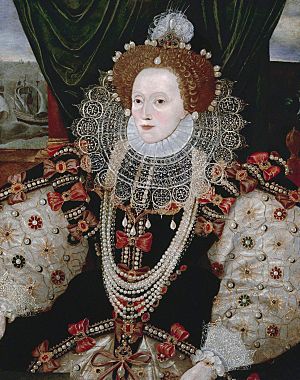
Two men, John Wood and Nicoll Elphinstone, sold Mary's jewels in England. Nicoll Elphinstone sold Mary's pearls to Queen Elizabeth, even though Catherine de' Medici also wanted them. The pearls were described as being as big as nutmegs. They are thought to be shown in Elizabeth's "Armada Portrait".
Jewels, Merchants, Loans, and Widows
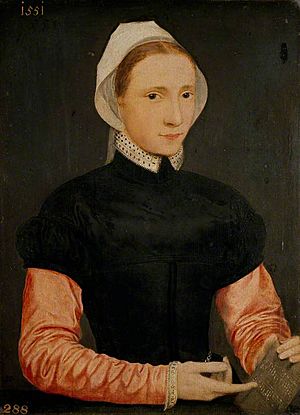
Some jewels sold by Regent Moray ended up with the widows of merchants who dealt with him. Helen Leslie, a widow, had an emerald pledged to her husband. This emerald was later sold in Paris.
Another widow, Helen Achesoun, had lent Moray money. She took some of Mary's "beltis and cousteris" as security. A "couster" was a gold chain that hung from a woman's belt with a pendant. One was described as a belt with a gold chain, decorated with white and red enameled roses.
Helen Achesoun later lent money to William Kirkcaldy, a supporter of Mary. She used more of the queen's jewels as security. In 1579, James VI paid money to get back jewels that had been pledged to his father during Regent Moray's time.
Mary Escapes and Goes to England
Mary wrote about a ring Elizabeth had sent her for "her succour" (help) in May 1568. After she escaped from Lochleven, Robert Melville brought some jewels to her. Mary used these jewels as tokens in letters to her allies and sent a ring to Queen Elizabeth.
After her defeat at the Battle of Langside, Mary went to England. It is said she stayed her last night in Scotland at Dundrennan Abbey. She may have given her host a ring. Mary sent a message from Dundrennan to Elizabeth, returning Elizabeth's ring as a token after her defeat.
Mary's secretary said she sent Elizabeth a diamond ring after Elizabeth had given her a heart-shaped diamond ring. Mary reminded Elizabeth in a letter in 1582 that when she escaped from Lochleven, she sent Elizabeth a diamond ring. This ring was a gift from Elizabeth, with a promise to help.
Mary continued to send rings as gifts. In 1581, she sent one to James VI, who promised to take good care of it. She planned to send James a jewel before her execution.
A Goldsmith at Bolton Castle
Mary had a goldsmith in her English household. He might have fixed her clothes. The goldsmith at Bolton Castle may have been Guyon Losselleur, who also worked for Mary in 1565.
Jewel Sales Are Halted
The sale of Mary's jewels by Moray in England was stopped for diplomatic reasons after she arrived in England. Mary asked the French King to prevent sales of her jewels in France. Most of her remaining jewels in Scotland were kept in a box in Edinburgh Castle.
In 1568, the Scottish Parliament allowed Regent Moray to sell Mary's jewels. However, Queen Elizabeth asked him not to, and Moray agreed. He claimed he and his friends had not gained any personal wealth from her goods.
An account of clothes and thread sent to Mary in Lochleven and England survives. It includes a coral and pearl belt with a matching hanging chain. This belt was sent to Mary in Carlisle in 1568.
Agnes Keith and the Great H of Scotland
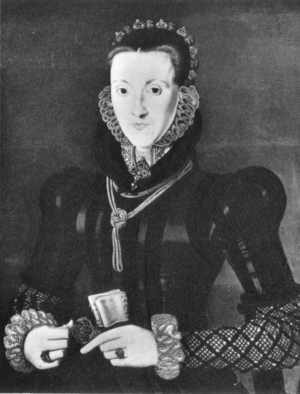
After Regent Moray was killed in 1570, Mary wrote to his widow, Agnes Keith, Countess of Moray, asking for "our H," the "Great H of Scotland," and other jewels. Moray had taken them to England and brought them back unsold. Mary's secretary wrote that they knew Agnes had taken possession of these jewels. Mary demanded they be delivered to her allies.
Mary added a note in her own handwriting that her family would be displeased if Agnes did not return them. Agnes Keith kept the jewels and did not reply. Mary wrote again in 1571, mentioning consequences for Agnes's children. The "Great H" may have been the priceless pendant Mary wore at her first wedding in 1558.
Regent Lennox, Moray's successor, also wanted the jewels from Agnes. Agnes Keith claimed the jewels were security for her late husband's unpaid expenses. She finally gave them to Regent Morton in March 1575.
Jewels and the Lang Siege
During the "Lang Siege" of Edinburgh Castle, the castle's captain, William Kirkcaldy of Grange, gave jewels to Mary's supporters as security for loans. He used the money to pay his soldiers. They also melted silver to make coins in the castle. Goldsmiths valued the jewels.
Many documents about the jewels and loans from this time are kept by the National Records of Scotland. These include a note about Mary's marriage ring.
The siege caused great suffering in Edinburgh. The new ruler, Regent Morton, tried to negotiate a surrender. He discussed forgiving Grange for using Mary's jewels to support her cause.
Grange did not surrender. English forces were called in to attack the castle. Morton worked hard to get the jewels back after the castle surrendered in May 1573. When soldiers entered the castle, James Mosman gave his share of the queen's jewels to Kirkcaldy, wrapped in an old cloth. The English commander found the jewel box and got some jewels back from lenders.
Mary said the jewels were hers. A supporter offered Morton £20,000 worth of Mary's jewels to save Grange's life. On August 3, 1573, William Kirkcaldy and others were executed.
Regent Morton and the Jewels
Morton got the records of the loans and pledges made by Kirkcaldy. Kirkcaldy had written notes in the margins of a jewel list about gifts made to Lady Thame, the wife of William Drury. Lady Thame had refused any gifts of Mary's jewels from him.
Mary Fleming, who helped make the jewel list, was ordered to return a ruby and diamond necklace. Agnes Gray, Lady Home, returned a jewel with fifteen diamonds and a pearl necklace. These had been her security for a loan. Two other men who had lent money to Grange were ordered to return the jewels pledged to them.
William Sinclair had sold 200 gold royal buttons to a lawyer. The lawyer returned the buttons to the Privy Council. In July 1573, Morton sent Mary's gold buttons and pearl-set "horns" to Annabell Murray to be sewn on the king's clothes.
Morton wrote to the Countess of Lennox, hoping she could get all the jewels still with William Drury in Berwick. The French ambassador said Morton reclaimed jewels from those in Scotland who held them as pledges, using threats. In October 1573, Morton sent money to get back one of the queen's headpieces.
Mary was unhappy about her jewels being with Morton and merchants. She wrote to the French ambassador, hoping Elizabeth I would help. Mary wanted a new list of her jewels and hoped they would be looked after in Scotland until her son James grew up.
A page stole several jewels, including a jeweled mermaid. This mermaid was similar to one Mary inherited from her father, James V. Mermaid jewels were often sewn on men's hats.
Morton had long talks with Moray's widow, Agnes Keith, to get back the diamond and ruby pendant called the "Great H of Scotland." Mary also wrote to Agnes, asking her to return the jewels to her instead. Agnes Keith claimed the jewels were security for her late husband's unpaid expenses. She finally gave them to Morton in March 1575.
In July 1575, there was a rumor that some of Mary's jewels had been taken out of England. Morton resigned as regent in March 1579. An inventory was made of royal jewels, Mary's clothes, and her dolls.
Mary in England
When Mary first arrived in England in July 1568, she asked a man named Garth Ritchie to ask John Sempill, the husband of Mary Livingston, to send her the jewels they were keeping. Garth Ritchie managed to bring some of Mary's clothes, but Regent Moray would not let Sempill send any jewels. Mary said the jewels Sempill had were gifts from the King of France and did not belong to Scotland.
At Coventry in 1569, the Duke of Norfolk gave a diamond to Lord Boyd to deliver to Mary. Mary wrote that she would keep the diamond around her neck until she could give it back to him.
Mary had some jewelry and precious items with her in England. Lists were made in 1586 and 1587. She usually wore a gold cross and pearl earrings. Another gold cross had religious scenes engraved on it. She kept a gold chain with miniature portraits of Henry II of France and Catherine de' Medici. This chain had 44 pieces with royal initials, enameled blue and red. It was probably worn as a belt.
A Mirror for Her Girdle
Mary wore a belt around her waist with a hanging chain and pendant. In 1575, she asked for a "fine gold mirror" as a pendant. She wanted it decorated with her initials and Elizabeth's combined. Mary's 1586 list includes a similar piece with her own portrait, to wear from her belt. There was also a gold pincase to wear on a belt. In the same letter, Mary asked for four copies of her portrait set in gold to give to her allies. These were possibly carved cameos or miniature paintings.
New Year's Day Gifts
Mary continued to give New Year's Day gifts of gold jewelry. In 1580, she asked her ally, the Archbishop of Glasgow, to help buy them. In 1581, Mary planned to declare that her jewels should be joined to the crown jewels of Scotland. She noted that most of her jewels were acquired in France. This was part of a plan to restore Mary as joint ruler of Scotland with her son.
Medical Materials
A longer list of Mary's jewels was made in 1586. It included two porcelain spoons, a bezoar stone (believed to be an antidote to poison) set in silver, and a slice of unicorn horn set in gold. There was also a charm stone against poison and another stone to guard against sadness. There were boxes of special clay (an antidote), powdered mummy, coral, and pearls. Some of these items were kept by her doctor.
Pyramus and Thisbe
The 1586 list includes a jewel given to Mary by Elizabeth I. It showed the story of Pyramus and Thisbe with mulberry trees. It was described as "A rock with golden shrubs, enriched with stones, representing the story of Pyramus."
This jewel was described again in 1587 as a rock with diamonds and rubies. It was said to be a gift from Elizabeth I eleven years before. King Henry VIII gave a similar jewel to Princess Mary in 1546. It was a brooch with the story of Pyramus and Thisbe, with a large diamond and four rubies. Mary I gave it to her sister, Elizabeth.
Jewels and Portraits with Political Messages
Mary wrote from Sheffield Castle in 1574 and 1575, asking her ally, the Archbishop of Glasgow, to order jewelry for her. She wanted gold lockets with her portrait to send to her friends in Scotland. She also wanted bracelets or a pendant. In 1578, she wrote again about a design for a gold and enamel token for her son.
These requests may be linked to the rosary beads and cross with an image of Susanna and the Elders, which Mary wore at her waist in her "Sheffield Portraits." The cross had the words "Angustiae Undique" (Beset on all sides). The Archbishop also sent Mary a watch in 1576.
The portraits she requested were likely small cameo portraits or miniature paintings. She also asked for a gold belt and necklace as a gift for her chancellor's daughter.
Lockets with miniature portraits were called "tablets." The Duke of Norfolk, who thought about marrying Mary, had a gold tablet with her picture in 1570. Mary sat for her portrait in Sheffield in 1577, planning to send it to the Archbishop of Glasgow. Her secretary asked his brother in Paris to buy bracelets and a heart-shaped diamond or emerald.
A sapphire ring owned by the Duke of Hamilton is thought to have been sent by Mary to Lord John Hamilton. Mary sometimes sent rings with letters to her supporters.
In 1578, Mary wrote to the Archbishop of Glasgow again, sending a design for a jewel for her son, James VI.
Around 1584, Robert Beale brought Mary a jewel shaped like a rock with pearls and rubies. This was likely a gift from Elizabeth I.
The Lion Shall Be Lord of All
In 1570, the Countess of Atholl and her friends had a jewel made that referred to who would inherit the English crown. The jewel was found in a package sent to Mary. It was described as being "no more than a man's hand" wide and "well decorated with gold and enamel."
The jewel showed a crowned queen in royal robes and the arms of Scotland, a thistle, a rose, and two lions. The motto was "Fall what may fall, the lion shall be lord of all." This message was about the succession to the throne. Mary owned a round jewel in 1586 with a lion engraved on an amethyst.
Lennox Jewel
The "Lennox Jewel," now in the Royal Collection, is a special jewel that spread a political message. It is thought to have been ordered by Mary's mother-in-law, Margaret Douglas, Countess of Lennox. Its main messages are in Scots. One says, "Whoever hopes constantly with patience will obtain victory in their claims." Another says, "My state to these I may compare, for you who are of rare goodness." Inside, it says, "What we resolve, death shall dissolve." It also has the initials MSL for Matthew Stewart Lennox and/or Margaret Stewart Lennox.
The Lennox Jewel's maker is unknown, but it has Scots mottoes. Researchers now think Margaret Douglas ordered it from a London maker.
The exact reason for the Lennox Jewel's creation is unclear. Some think it was a gift for Mary before her marriage to Lord Darnley around 1564. Others believe its symbols relate to James VI and his claim to the English throne.
Mary in Chains
Some jewels were made to insult Mary. The Spanish ambassador reported that the Earl of Leicester gave Queen Elizabeth a New Year's Day gift in 1571. It was a miniature painting showing Elizabeth on her throne with Mary in chains at her feet. Spain, France, and Neptune were shown bowing to Elizabeth.
Relics and the Earl of Northumberland
Mary owned two holy thorns, which were relics from the crown of thorns. These were a gift from her father-in-law, Henri II. Mary is said to have given the thorns to Thomas Percy, 7th Earl of Northumberland. One is now at Stonyhurst College, housed in a gold container decorated with pearls. Another similar container for Mary's other thorn is at Saint Michael's Church, Ghent.
Mary sent other gifts to the Earl of Northumberland, including an enameled gold ring and a diamond ring. For the Countess of Northumberland, she sent perfumed gold rosary beads that the Pope had given Mary. The Earl sent Mary a jewel that had been a gift to his wife and a diamond ring from the Countess. Mary swore she would always wear it.
Crucifixes and Rosaries
In 1566, an English spy visited Mary at Edinburgh Castle. Mary's secretary wrote that the spy gave her an ivory locket showing the crucifixion. Mary's 1586 list mentions a gold cross she usually wore and another engraved with religious scenes.
A gold and enameled crucifix is said to have been Mary's gift to the Abbot of Westminster. It supposedly contained a piece of the True Cross. A simpler silver crucifix found at Craigmillar Castle is also said to have been hers. A 1500s locket with a cameo of the crucifixion is said to have been Mary's gift to Thomas Andrews before her execution.
The Abbot Feckenham's cross and the gold rosary beads with a crucifix, said to be those worn at her execution, are part of the collection at Arundel Castle. Another rosary of garnet beads with a silver gilt crucifix, thought to belong to Mary, is displayed at Holyroodhouse.
According to one account, the gold cross at Fotheringhay Castle contained a piece of the True Cross. Mary passed it to one of her ladies, but the executioner took it. Other accounts mention beads hanging at her belt and an ivory crucifix in her hands.
A portrait of Mary in the Scottish Portrait Gallery shows her wearing a crucifix and a rosary of black and gold beads. The center of the cross has a round picture of Susanna and the elders, with the words "angustiae undique" – trouble is all around.
James VI
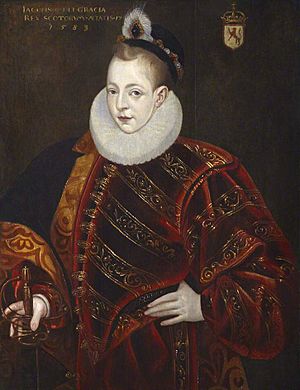
James VI was able to wear the jeweled gold buttons that belonged to his mother. He also used gold settings from her necklaces to decorate his hats. In 1579, he became an adult ruler. He ordered his mother's jewel box to be moved from Edinburgh Castle to Holyroodhouse. In 1581, Mary sent him a ring, and he sent one back, saying he received hers "in as good heart" as she took his.
James gave some of his mother's jewels to his friend Esmé Stewart, 1st Duke of Lennox in 1581. These included the "Great H" and a gold cross with seven diamonds and two rubies. In 1584, a German writer saw James wearing this cross on his hat ribbon. This was probably the same cross his grandmother, Mary of Guise, had pawned for money.
The Emerald and Diamond Tablet
In 1584, James VI got a loan from Edinburgh. As security, his servant delivered a jewel called a tablet, with a large emerald and a diamond. In 1589, the jewel was returned to the king as a wedding gift. It was updated and presented to Anne of Denmark when she arrived in Edinburgh in 1590.
James Stewart, Earl of Arran
When a diplomat visited Scotland in 1583, James VI gave him a ring. However, the Earl of Arran had replaced the diamond with an inexpensive crystal. The Earl and Countess of Arran told the Master of Gray to dress the king in his exiled mother's jewels. They had one of the queen's headpieces, with diamonds, pearls, and rubies, broken up to decorate a cloak for the young king in 1585. Later, some of the gold settings were put on a hat string.
The Countess of Arran was said to have made new keys for the boxes with Mary's jewels and clothes. She reportedly tried on many of the old queen's garments.
The Countess of Arran was imprisoned in 1585 for giving her husband jewels worth 20,000 crowns. He was trying to leave the country. He carried royal jewelry, including the "Kingis Eitche" (the Great H of Scotland). He was forced to give up his treasure. Arran returned all the jewels in 1586.
Thomas Foulis and England
James VI gave some jewels to a goldsmith and financier, Thomas Foulis, to sell in England in the 1590s. In 1603, King James gave a jewel that belonged to Mary to James Sempill. This was a reward for his good service. The jewel was a necklace with a diamond and a ruby, and a locket with a diamond and ruby.
In 1604, King James had the "Great H" taken apart. The large diamond was used in the new "Mirror of Great Britain" which James wore as a hat badge.
The Eglinton Parure
A necklace from the collection of the Earls of Eglinton is believed to have been a gift from Mary to Mary Seton. The necklace has "S-shaped snakes in translucent dark-green enamel." It was divided into two pieces in the 1600s. One part is at the National Museum of Scotland, and the other is at Holyrood Palace. These may have been parts of a longer chain.
The necklace and a painting were said to have come to the Eglinton family in 1611. In 1847, Mary's biographer visited Eglinton Castle and borrowed the necklace. In 1894, the Earl of Eglinton rediscovered the necklace in his castle. He sold it at auction. Another part of the necklace is at Duns Castle. This part came to the Hay family when Elizabeth Seton married William Hay in 1694.
Golf and the Seton Necklace
Mary, Queen of Scots and Lord Darnley played games like bowls and made high bets. In 1565, when Mary Beaton won, Darnley gave her a ring and a brooch. A similar story is told about the Seton necklace. It is said that the queen gave it to Mary Seton after she won a game of golf at Seton Palace. Mary did play golf at Seton. Her accusers later said she played "pall-mall and golf" after Darnley's death.
The Penicuik Jewels and Gillis Mowbray
The Penicuik jewels are family treasures of the Clerk family. They include a necklace, locket, and pendant. The necklace has 14 large open-work beads that could be filled with scented musk. The locket has tiny portraits of a woman and a man, believed to be Mary and James VI. The gold pendant with pearls may have been worn with the locket. The Penicuik jewels are displayed at the National Museum of Scotland.
These pieces are traditionally believed to have belonged to Gillis Mowbray, who served Mary in England. Gillis Mowbray joined Mary's household in 1585. Mary gave Gillis Mowbray jewels, money, and clothes, including gold bracelets and a crystal jewel set in gold. She also kept Mary's musical instruments.
Mary bought clothes and jewels for her household women. In 1583, she wrote about preparing a new black gown and ordering a "garniture" (decoration) from London.
The history of the Penicuik jewels was described in 1923. Gillis Mowbray's daughter married Sir William Gray, and their daughter married John Clerk, who bought the Penicuik estate.
The Inventories
Most of the lists and papers about Mary's jewels are kept by the National Records of Scotland. They were written in French or Scots. Some were published in the 1800s. A 1906 book tried to connect jewelry and costumes in Mary's portraits with the descriptions in the lists.
Original documents include:
- Inventory of jewels Mary received from Regent Arran, 1556. It includes a cupid with a ruby heart and a mermaid with a diamond mirror.
- 'Memoir of the Crown', a list of Mary's jewels, including the Great H, 1550s.
- Inventory of the jewel box in Edinburgh Castle, 1571, signed by Mary Fleming and others.
- Statements by William Kirkcaldy of Grange about the jewels, 1573.
- Inventory of jewels found after the siege by William Drury.
- Copy of William Drury's inventory, mentioning Mary's marriage ring.
- Answers of Robert Melville, 1573.
- Inventory of Mary's goods in Edinburgh Castle, 1578, including her books and dolls.
- Inventory made at Fotheringhay after Mary's execution, 1587.


